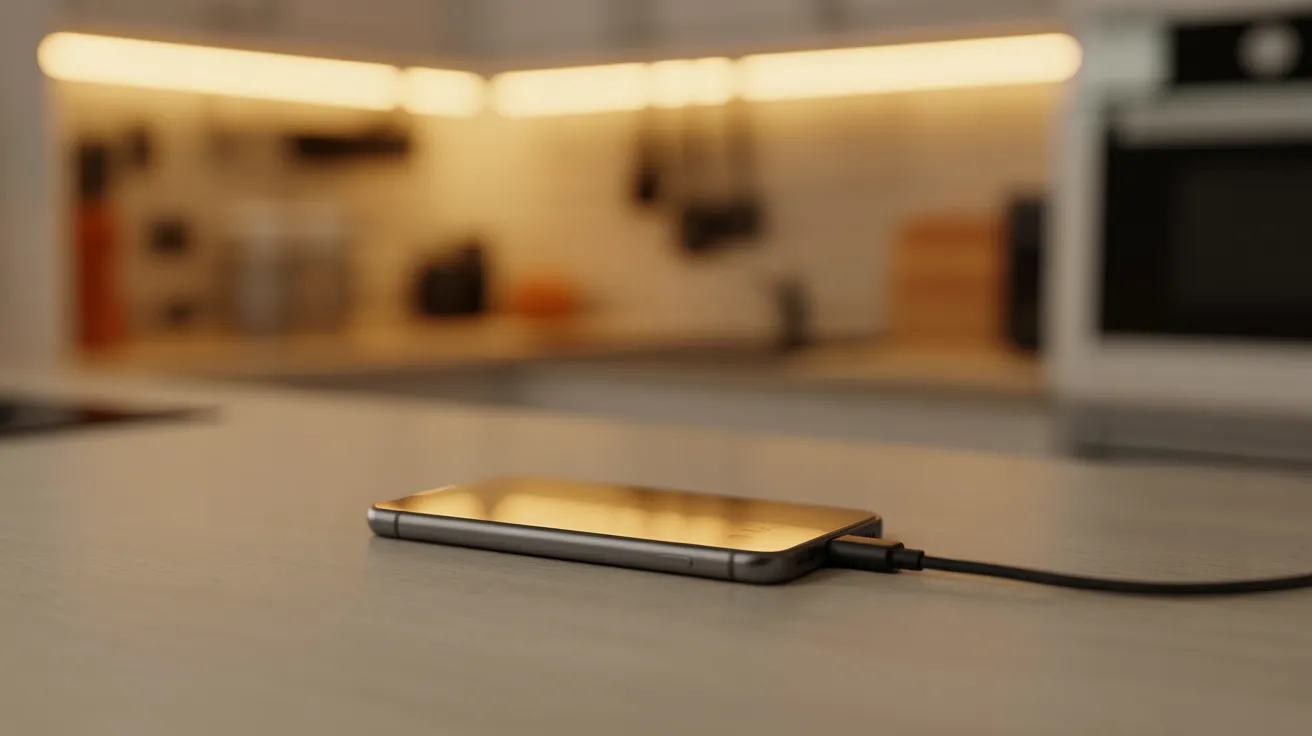
You reach for it the moment you wake up. It’s the last thing you see before you fall asleep. It’s your constant companion in line at the grocery store, a silent guest at the dinner table, and the first thing you grab during a moment of boredom. Your phone is a powerful tool, but its constant presence often comes at a cost—to your focus, your relationships, and your mental peace.
The feeling is familiar to many of us: a scattered mind, a conversation half-heard, a task interrupted by a single, buzzing notification. We feel an unspoken pressure to be always available, always connected, always responsive. But this state of constant digital tethering can leave us feeling drained, anxious, and disconnected from the world right in front of us.
The good news is that you don’t have to abandon technology to reclaim your attention. The solution isn’t a dramatic digital detox or a return to a flip phone. Instead, it’s about learning how to manage phone use with intention. It’s about creating thoughtful, sustainable tech boundaries that allow you to use your device as a tool, not be used by it.
This guide is for anyone who wants to build a healthier relationship with their phone. We won’t ask you to delete your favorite apps or go off the grid. We will, however, provide you with practical strategies to set meaningful phone boundaries, reduce digital noise, and find a more focused, present, and balanced way of living alongside your technology.
📚 Table of Contents
- Understanding Why Your Phone Is So Hard to Put Down
- Building Your Digital Routines for Better Focus
- Set Up Your Phone’s “Focus Mode”
- Practice Notification Triage and Batching
- Design a Minimalist Home Screen
- Use App Timers to Build Awareness
- Creating Environments That Support Your Boundaries
- Establish Screen-Free Zones and Times
- Cultivate a Sleep-Friendly Evening Routine
- Use Environmental Cues for Deep Work
- Worked Examples: Putting Boundaries into Practice
- Troubleshooting Common Challenges
- Handling Moments of Relapse
- Navigating FOMO (Fear of Missing Out)
- Managing Social and Professional Expectations
- Frequently Asked Questions (FAQ)
- How can I set phone boundaries with family without causing conflict?
- I work a night shift. How can I adapt sleep hygiene advice?
- Do parental controls and app blockers actually work for adults?
- My job requires me to be available and responsive. How can I possibly set boundaries?
- What about privacy concerns with screen time tracking apps?
- Your First Steps to a Healthier Relationship with Your Phone
Understanding Why Your Phone Is So Hard to Put Down
Before we can build effective boundaries, it’s crucial to understand the forces at play. Your struggle to disconnect isn’t a personal failing or a lack of willpower. It’s the result of a carefully engineered system designed to capture and hold your attention for as long as possible.
Our brains are wired to seek rewards and respond to novelty. Technology companies understand this fundamental aspect of human psychology exceptionally well. Many apps and platforms are built around a concept known as the dopamine loop. Dopamine is a neurotransmitter in the brain that plays a major role in motivation and reward. When you do something pleasurable, like eating a delicious meal or receiving a compliment, your brain releases a small amount of dopamine, making you feel good and encouraging you to repeat the behavior.
Your phone leverages this system with precision. Every notification, every “like” on a photo, every new email, and every surprising discovery on a social media feed triggers a tiny dopamine hit. The rewards are unpredictable—you never know which notification will be important or which post will be interesting. This is called a variable reward schedule, and it’s the same psychological principle that makes slot machines so addictive. The uncertainty keeps you checking, scrolling, and refreshing, always hoping for the next little reward.
Think about the last time you mindlessly opened a social media app. You weren’t looking for anything specific, but you scrolled, and scrolled, and scrolled. The infinite scroll feature is a perfect example of this design. There is no natural stopping point, no end to the content, which removes any friction that might prompt you to close the app. It creates a state of passive consumption that can easily turn minutes into hours.
Recognizing these mechanisms is the first step toward empowerment. When you understand that your phone is designed to be compelling, you can shift from blaming yourself to strategically building a defense. Setting phone boundaries is about consciously overriding these automated systems to reclaim your time and attention.
For more information on the psychological principles behind behavior and technology, authoritative resources like the American Psychological Association (APA) provide extensive research and articles on human psychology and its interaction with the digital world.

Building Your Digital Routines for Better Focus
Creating boundaries isn’t about rigid rules; it’s about building new habits and routines that put you back in control. By making conscious decisions about how and when you interact with your phone, you can significantly reduce its power over your attention. Here are a few powerful routines you can start implementing today.
Set Up Your Phone’s “Focus Mode”
Most modern smartphones come with powerful “Focus” or “Do Not Disturb” (DND) modes that are highly customizable. These are your first line of defense against unwanted interruptions. Instead of simply turning notifications on or off, you can create different profiles for different contexts of your life.
Do Not Disturb (DND) is a feature that silences all calls, alerts, and notifications on your device. You can typically schedule it for certain times, like overnight, or turn it on manually when you need to concentrate. Most DND settings allow you to create exceptions, such as allowing calls from specific contacts (like family) or repeated calls from the same number, which could signal an emergency.
Consider setting up a few different focus modes:
Work Mode: Allow notifications only from work-related apps like Slack, your calendar, and email. Silence everything else, especially social media and news apps.
Personal Mode: When you’re spending time with family or friends, allow calls and messages from your inner circle but block work emails and other professional alerts.
Sleep Mode: Schedule this to turn on automatically an hour before bed and turn off after you wake up. It should silence almost everything and can even dim your lock screen to be less stimulating.
The key is to be intentional. Take 15 minutes to explore these settings on your phone. By tailoring them to your life, you transform your device from a constant source of distraction into a tool that respects your current priorities.
Practice Notification Triage and Batching
Notifications are the primary way apps pull you back to your screen. Each buzz or ping is an invitation to stop what you’re doing and pay attention to something else. The most effective way to manage this is to perform a “notification triage.”
Go into your phone’s settings and review the notification permissions for every single app. For each one, ask yourself: “Do I truly need to be notified by this app in real-time?” You’ll likely find that very few pass the test. Most notifications can be turned off completely without any negative consequences.
For the apps that remain, consider changing the delivery method. Instead of instant alerts, you can use a technique called notification batching. This is a feature on some operating systems (often called a “Scheduled Summary”) where non-urgent notifications are collected and delivered to you in a single batch once or twice a day. This allows you to stay informed without constant interruptions. You choose when to check the summary, putting you in control of the information flow.
Design a Minimalist Home Screen
Your home screen is prime digital real estate. If it’s cluttered with colorful, attention-grabbing apps, you are more likely to open them out of habit or boredom. A minimalist home screen, on the other hand, reduces temptation and promotes intentional use.
Start by removing all but the most essential, tool-based apps from your home screen. These are apps that serve a specific function, like Maps, Camera, or your Calendar. Move all the other apps—especially social media, news, and games—to a second or third page, or place them in a single folder labeled “Distractions.”
This simple act adds a moment of friction. Instead of mindlessly tapping an icon, you have to actively swipe and search for the app. That small pause is often enough to make you reconsider: “Do I really need to open this right now?” Many people also find that changing their screen to grayscale can make it significantly less appealing, reducing the time they spend on it.
Use App Timers to Build Awareness
Most of us severely underestimate how much time we spend on our phones. App timers and screen time widgets are not meant to be punitive; they are tools for awareness. Go into your settings and set daily time limits for your most-used apps, like Instagram, TikTok, or YouTube.
Start with a reasonable limit—perhaps just under your current daily average. When you reach your limit for the day, the phone will notify you. While you can usually override it, that notification serves as a powerful reminder of your intention. Just seeing the data can be a catalyst for change, helping you make more conscious choices about where you invest your time.

Creating Environments That Support Your Boundaries
Your physical environment plays a huge role in the success of your digital habits. By consciously designing your spaces, you can create cues that make it easier to disconnect and harder to fall into old patterns. Setting strong phone boundaries extends beyond the device itself and into the world around you.
Establish Screen-Free Zones and Times
Designating certain areas of your home as “screen-free zones” can be incredibly effective. The most powerful choice is the bedroom. Keeping your phone out of the bedroom entirely can dramatically improve your sleep and your relationship with your partner.
The dining table is another excellent candidate. When you sit down for a meal, leave your phone in another room. This simple rule encourages conversation and mindful eating, strengthening phone boundaries with family and allowing for genuine connection. You might also consider making your morning coffee routine or the first 30 minutes after you get home from work screen-free periods.
The goal is to create pockets of your day and spaces in your home where your mind is free from digital input. These small sanctuaries give your brain a chance to rest, wander, and engage with the physical world.
Cultivate a Sleep-Friendly Evening Routine
The light from our screens can have a significant impact on our sleep quality. Specifically, the blue light emitted by phones, tablets, and computers can suppress the production of melatonin, the hormone that signals to your body that it’s time to sleep. As a leading authority on sleep health, the Sleep Foundation regularly emphasizes the importance of reducing blue light exposure in the evening.
To counter this, aim to put your phone away at least 60-90 minutes before you plan to go to sleep. Use this time for calming, analog activities like reading a physical book, light stretching, listening to music, or talking with a loved one. If you absolutely must use your phone in the evening, use a “Night Shift” or “Eye Comfort Shield” mode, which shifts the screen’s colors to a warmer, less-disruptive spectrum.
Charging your phone overnight in a different room, like the kitchen or living room, is a game-changing habit. This removes the temptation to scroll in bed and ensures your alarm clock is the only digital interaction you have before starting your day with more intentional activities.
Use Environmental Cues for Deep Work
If you work from home or need to do focused work, your environment can either help or hinder you. To signal to your brain that it’s time for deep concentration, create a specific set of cues. This could involve putting your phone on a charging stand across the room, out of arm’s reach but still visible if you’re expecting an important call.
Place it face down so you can’t see the screen light up. Better yet, turn on your “Work” focus mode before you begin. You might also use other cues, like putting on a specific playlist of instrumental music, closing your office door, or lighting a candle. When you consistently use these cues, your brain learns to associate them with a state of focus, making it easier to resist the urge to check your phone for a “quick break” that turns into 20 minutes of scrolling.
By shaping your environment, you make your desired behavior the easier choice. It requires less willpower to avoid your phone when it’s not physically present or accessible, allowing you to build lasting tech boundaries that support your goals.

Worked Examples: Putting Boundaries into Practice
Theory is helpful, but seeing how these strategies work in real life can make them feel more accessible. Here are two practical, worked-out examples of how to implement healthy phone boundaries without completely overhauling your life.
Example 1: A 10-Minute Evening Wind-Down
The Goal: To create a small, consistent buffer between screen time and sleep time to improve sleep quality and reduce morning grogginess.
The Problem: Sarah typically scrolls through social media and news feeds right up until the moment she turns off the light. She often feels her mind is racing when she tries to sleep and feels tired when she wakes up.
The Plan:
Step 1: Set a “Digital Curfew” Alarm. Sarah sets a recurring alarm on her phone for 10:00 PM, 30 minutes before her desired bedtime. The alarm is labeled “Time to Wind Down.”
Step 2: Change Locations. When the alarm goes off, she stands up, says goodnight to her phone, and plugs it in to charge on her kitchen counter for the night. This physical separation is key.
Step 3: Prepare the Environment. She goes to her bedroom, dims the lights, and ensures her book and a glass of water are on her nightstand. This creates a calm, inviting atmosphere.
Step 4: Engage in a 10-Minute Analog Activity. For the next 10 minutes, Sarah does something simple and calming. Some nights, she reads a few pages of a novel. Other nights, she does some gentle stretching or jots down a few thoughts in a journal. The activity itself is less important than the fact that it’s screen-free.
Step 5: Transition to Sleep. After her 10-minute activity, she feels noticeably calmer. She turns off the light and finds it easier to fall asleep without the lingering stimulation from her screen. Even this small routine creates a powerful boundary that protects her rest.
Example 2: A Realistic Weekend “Digital Reset”
The Goal: To reduce mindless phone use over the weekend and reconnect with hobbies and family, without feeling completely disconnected from the world.
The Problem: David finds his weekends are often consumed by his phone. He wants to be more present with his kids but finds himself constantly checking emails, news, and social media out of habit.
The Plan:
Step 1: Define the Boundaries on Friday Night. David decides his “reset” will last from Saturday morning until Sunday afternoon. He’s not going phoneless, but he’s setting clear rules for managing phone use.
Step 2: Reconfigure the Phone. He activates a custom “Weekend” Focus Mode. This mode silences all notifications except for calls and texts from his wife and parents. He moves his email and social media apps into a folder on his last home screen page, renaming it “Open Intentionally.”
Step 3: Schedule “Check-In” Times. Instead of constant checking, David sets two 15-minute check-in times per day: one around noon and one around 5:00 PM. During these times, he can briefly scan emails for anything urgent and look at social media if he chooses. He sets a timer to ensure he sticks to the 15-minute limit.
Step 4: Plan Alternative Activities. Knowing that boredom is a major trigger for phone use, David plans a few activities for the weekend: a trip to the park with the kids, working on a puzzle, and cooking a new recipe. Having a plan fills the time that might otherwise be spent scrolling.
The Result: David finds that he feels more relaxed and engaged. By replacing reactive checking with intentional check-ins, he removes the mental burden of constant connectivity. He still uses his phone for its tool-like functions—taking photos at the park, looking up the recipe—but it no longer dictates the flow of his weekend.

Troubleshooting Common Challenges
Building new habits is rarely a linear process. You will have moments of relapse, face social pressures, and struggle with the fear of missing out. Acknowledging these challenges ahead of time can help you navigate them with more grace and resilience.
Handling Moments of Relapse
There will be a day when you spend hours scrolling despite your best intentions. This is not a failure; it’s a data point. Instead of feeling guilty, get curious. Ask yourself: What triggered this? Was I feeling bored, stressed, lonely, or anxious? Understanding the underlying emotion can help you find a more constructive way to cope next time.
If stress was the trigger, perhaps a short walk or a few deep breaths would be a better response. If it was loneliness, maybe calling a friend would be more fulfilling than scrolling through their feed. Treat each relapse as a learning opportunity, not a reason to abandon your efforts to manage phone use.
Navigating FOMO (Fear of Missing Out)
FOMO is a powerful driver of compulsive phone checking. We worry that if we disconnect, we’ll miss an important news update, a social invitation, or a crucial piece of information. The reality is that most of what happens online is not urgent.
To combat FOMO, try shifting your mindset to JOMO—the Joy of Missing Out. Celebrate the things you gain when you disconnect: deeper focus on a task, an uninterrupted conversation with a loved one, the simple pleasure of observing the world around you. Remind yourself that by saying no to constant digital noise, you are saying yes to your own well-being and the life happening right in front of you. Over time, you’ll realize you aren’t missing much at all.
Managing Social and Professional Expectations
One of the biggest hurdles can be the expectations of others. Colleagues might expect instant email replies, and friends might wonder why you didn’t immediately “like” their photo. This is where clear communication about your phone boundaries can help.
You don’t need to make a grand announcement, but you can set expectations in subtle ways. Add a line to your email signature that says, “I check emails twice a day to maintain focus.” Let your friends and family know, “If you need me urgently, please call, as I’m trying to be on my phone less.”
Most people will understand and respect your intentions. By modeling healthier tech boundaries, you may even inspire them to do the same. Remember, your time and attention are yours to give, and it’s okay to protect them.

Frequently Asked Questions (FAQ)
Here are answers to some common questions about setting and maintaining healthy phone boundaries.
How can I set phone boundaries with family without causing conflict?
This is a common concern when trying to establish new phone boundaries with family. The key is to frame it collaboratively and positively. Instead of saying, “Stop using your phone at dinner,” try, “I’d love for us to have a tech-free dinner so we can really connect. How about we all put our phones in a basket for that one hour?” By making it a shared goal rather than a personal demand, you invite cooperation. Explain your ‘why’—that you want to be more present with them. When people understand your motivation is to strengthen your relationship, they are much more likely to be supportive.
I work a night shift. How can I adapt sleep hygiene advice?
The core principles remain the same, even if the timing is different. Your “evening wind-down” is simply the period before you go to sleep, whether that’s at 9:00 PM or 9:00 AM. The goal is to create a buffer between stimulating screen time and rest. Try to stop using your phone at least 60 minutes before your scheduled sleep time. Use blackout curtains to block daylight and create a dark, sleep-conducive environment. The concept of a “digital sunset” applies to your personal schedule, not the sun’s. Protecting your sleep is crucial for your health, a fact supported by extensive research from institutions like the National Institutes of Health (NIH).
Do parental controls and app blockers actually work for adults?
Yes, they can be surprisingly effective tools for self-regulation. While often marketed for children, these apps can provide the necessary friction to break cycles of mindless use. Using an app to block social media during your designated work hours, for example, offloads the need for constant willpower. It automates your boundary. The goal isn’t to lock yourself out forever, but to make your desired behavior the path of least resistance. Think of them as training wheels while you build stronger, more intuitive habits for managing phone use.
My job requires me to be available and responsive. How can I possibly set boundaries?
This is a challenging but not insurmountable situation. The key is to differentiate between being “available” and being “always on.” Talk to your manager to clarify expectations. Are you expected to respond to emails at 10 PM, or is that just a habit the team has fallen into? Often, expectations are less rigid than we assume. You can implement boundaries like turning off work-related notifications after a certain hour and using an auto-reply to acknowledge receipt and state that you’ll respond during business hours. For truly urgent matters, establish a specific channel, like a phone call. This allows you to disconnect from the constant flow of non-urgent messages while still being reachable in an emergency.
What about privacy concerns with screen time tracking apps?
This is a valid concern. The built-in screen time trackers on most modern operating systems (like Apple’s Screen Time or Android’s Digital Wellbeing) are generally secure as they are part of the core OS and process data on the device itself. If you consider using a third-party app, it’s crucial to research their privacy policy. Look for apps that prioritize user privacy, are transparent about the data they collect, and have a strong reputation. For many people, the native, built-in tools provide more than enough functionality without introducing additional privacy risks.

Your First Steps to a Healthier Relationship with Your Phone
Reclaiming your focus and building a balanced digital life is a journey, not a destination. It’s about making a series of small, intentional choices that, over time, add up to a significant change. You don’t need to do everything at once. The most sustainable approach is to start small and build momentum.
The goal is not to eliminate your phone but to put it in its proper place: as a powerful tool that serves your intentions, rather than a demanding master that dictates your attention. By consciously implementing routines, shaping your environment, and communicating your needs, you can find a more peaceful and present way to coexist with technology.
Here are a few small changes you can adopt this week to begin building healthier phone boundaries:
* Move One Distracting App. Take your most time-consuming social media or news app and move it from your home screen into a folder on the second page. Just this tiny bit of friction can cut down on mindless opens.
* Choose One Screen-Free Zone. Decide on one place or time where your phone isn’t welcome. The easiest place to start is the dinner table. Make it a family rule or a personal commitment.
* Set One App Timer. Go into your phone’s settings and set a 30-minute daily limit on your most-used app. Don’t worry about being perfect; just observe how it feels to be made aware of your usage.
* Charge Your Phone Outside Your Bedroom Tonight. If you do only one thing, make it this. Buy a cheap alarm clock if you need one. Protecting your sleep is the single most impactful boundary you can set.
Start with one of these. See how it feels. The path to digital wellness is paved with these small, consistent acts of intention. You have the power to reshape your relationship with your device, one boundary at a time.
Disclaimer: The information provided in this article is for informational purposes only and is not intended as a substitute for professional medical or psychological advice, diagnosis, or treatment. Always seek the advice of your physician or other qualified health provider with any questions you may have regarding a medical condition or mental health.






